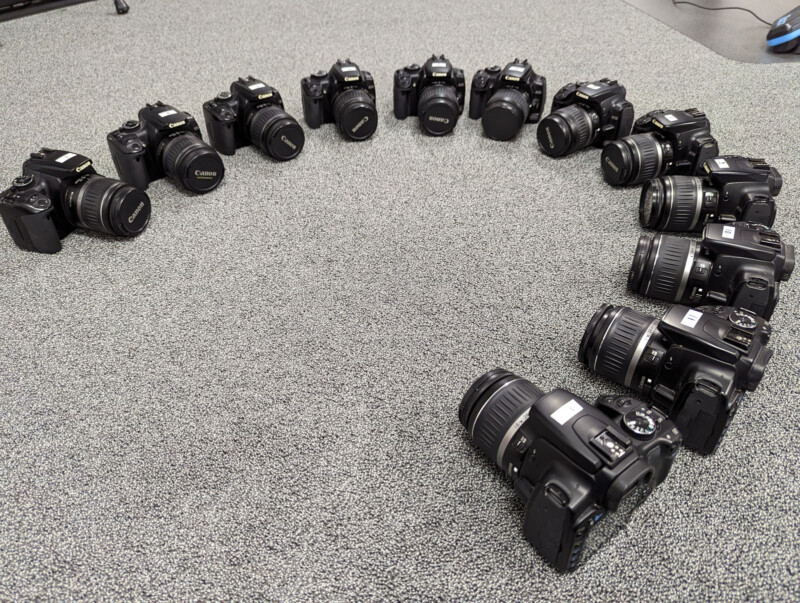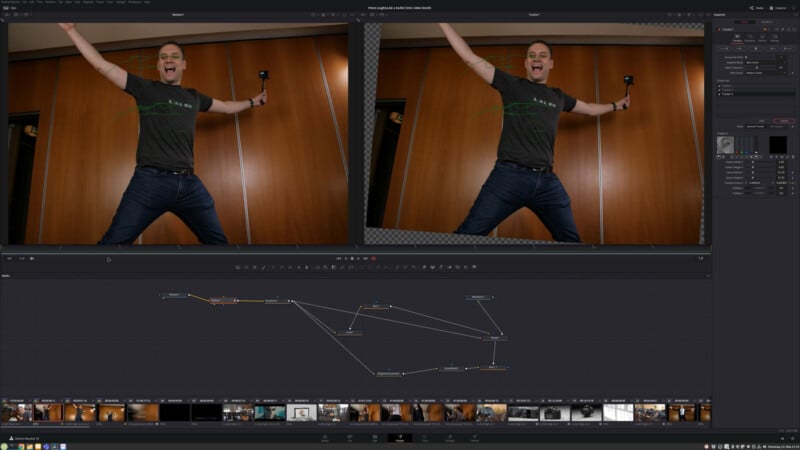Traditional photo booths at weddings are old news. Sebastian Staacks, who describes himself as someone who loves to “create stuff,” built a bullet time video booth for his cousin’s wedding.
On his website, There Oughta Be, Staacks decided that there ought to be bullet time at a family wedding reception. Not one to let ideas stay ideas, Staacks got to work.

“I have created a bullet time video booth. Not a typical photo booth that you can find at many wedding receptions where guests take pictures, but a video booth that uses the bullet time effect as a transition between clips,” Staacks tells PetaPixel.
“It uses an array of old Canon EOS 400D DSLR cameras and automatically generates preview clips on-site with an old laptop,” Staacks continues. Outside Europe, the 400D is known as the Rebel XTi (North America) and the Kiss Digital X (Asia).
![]()
The bullet time booth isn’t Staacks’ first foray using video instead of still photography at a wedding.
“The story of this project begins in 2017 when I created a video booth for my wedding. At many wedding receptions, you can find photo booths, which are simple camera setups with a remote trigger to allow guests to create some memories of the special day. Usually this involves silly props like hats, wigs, and giant glasses and it is as much about creating photos as a memory as it is about the fun of being creative while doing so,” he explains. “For my wedding, I mixed it up a bit by putting my Sony NEX-5T on a tripod and allowing guests to take short five-second clips instead of static photos. Later, I cut all the clips into one long video with upbeat music, and we still enjoy watching this memory today.”
![]()
The video booth setup got a second chance a few years later at another family wedding, and this year, another family member wanted the booth but Staacks wanted to “try something new by adding a bullet time effect.”
Bullet time was made famous in the 1999 blockbuster hit, “The Matrix.” In that movie, numerous scenes included slow-motion and frozen time with rotating camera perspectives. While this can be achieved using computer-generated graphics, it can also be shot in-camera by using an array of multiple still cameras surrounding the subject. Multiple cameras make it possible to create a “virtual” camera that rotates around the subject.
![]()
While popularized by “The Matrix,” the bullet time technique arguably owes a debt to Eadweard Muybridge’s chronophotography work in 1878, Harold Edgerton’s images of bullets in the 1940s, and Tim Macmillan, a cinematic pioneer who created a circular arrangement of pinhole cameras in the 1980s. Similar techniques have also been shown in animation, including the “Speed Racer” anime series in the 1960s.
These days, it’s hard to find action movies and video games that don’t employ some slow-motion bullet time-esque effect. As Staacks writes, “It pretty much became a movie cliché.”
![]()
As he also explains, while the effect is easily achieved using computer rendering, users must have many cameras to capture bullet time video clips in real life. In his case, he grabbed over a dozen Canon 400D DSLR cameras online from numerous sellers. Staacks offered each seller around $50, and they either accepted or he moved onto the next seller.


Staacks set up the Canon cameras on stands partially encircling where people would stand for their video portraits. He also needed a bundle of power supplies, a Raspberry Pi, an on-site laptop, and a Sony a5000 to capture b-roll.
His full breakdown of the setup includes detailed information about wiring, lighting, and the software, which proved quite challenging to design. Staacks ran DaVinci Resolve on an old Dell XPS notebook, complete with some simple repeatable trackers in the video editing app, which proved quite effective.
Image credits: Sebastian Staacks
DSLR-Powered Bullet Time Video Booth Brings 'The Matrix' to Weddings - PetaPixel
Read More

No comments:
Post a Comment